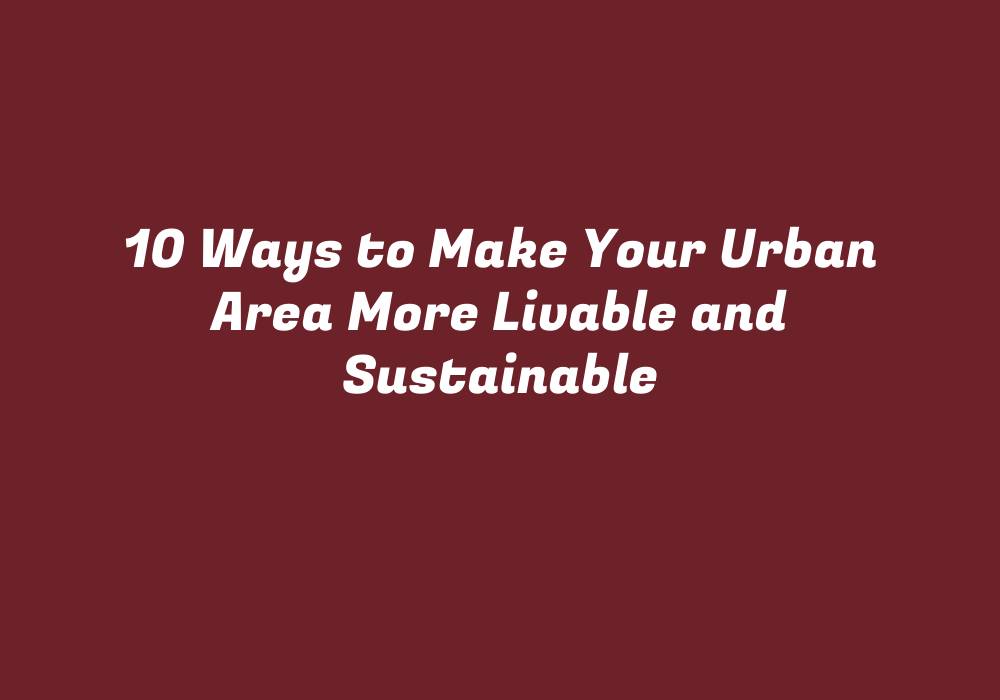10 Ways to Make Your Urban Area More Livable and Sustainable
Introduction
As the world population continues to increase, more people are moving to urban areas seeking better opportunities. However, this rapid growth can lead to issues like pollution, congestion, and a lack of resources. To address these challenges, it’s essential to find ways that promote a more livable and sustainable environment. In this article, we explore ten practical strategies that can help transform your urban area into a more enjoyable and eco-friendly space for everyone.
1. Promote Urban Agriculture
Incorporating agriculture within the city can contribute significantly towards making it more sustainable and self-sufficient. By growing food locally, communities can reduce their reliance on long-distance transportation and improve access to fresh produce. There are numerous approaches such as rooftop gardens, community gardens, vertical farms, or even urban farming in vacant lots which can be utilized to implement this concept effectively.
2. Support Public Transit Systems
Encouraging the use of public transport is another crucial aspect in reducing traffic congestion and air pollution. Investing in well-connected networks that are affordable and accessible for all residents would not only improve their mobility but also help reduce greenhouse gas emissions. Additionally, prioritize bicycle lanes and pedestrian walkways to foster active commuting and promote a healthier lifestyle.
3. Improve Walkability of Streets and Neighborhoods
Creating a more walkable environment can lead to healthier residents and encourage social interaction within communities. By incorporating green spaces, parks, benches, and well-designed sidewalks into street layouts, people will be encouraged to spend more time outdoors. This can result in increased physical activity, reduced stress levels, and improved overall quality of life for urban dwellers.
4. Embrace Green Infrastructure and Rainwater Harvesting
Urban areas face issues like flooding due to their limited capacity to absorb rainwater. By incorporating green infrastructure elements such as permeable pavements, rain gardens, and swales, it becomes easier for water to infiltrate the soil naturally. In turn, this reduces runoff into sewers and drains, ultimately contributing to a healthier environment and mitigating the risk of flooding.
5. Encourage Energy-efficient Building Designs
Implementing eco-friendly building practices is crucial in making urban areas more sustainable. By utilizing energy-efficient materials, optimizing natural light, and incorporating renewable energy sources, such as solar panels or geothermal systems, these structures can significantly reduce their environmental impact while lowering energy costs for residents.
6. Foster Community Engagement and Collaboration
Encouraging community participation in local planning processes is crucial to ensure that urban developments are well-suited to meet the unique needs of the people who live there. By involving residents from diverse backgrounds, cities can gain valuable insights into their priorities and develop more inclusive and sustainable plans that address their concerns effectively.
7. Prioritize Local and Sustainable Products and Services
Promoting a local economy where residents support small businesses and locally-made products fosters a sense of community and contributes to a reduced carbon footprint. In addition, sourcing energy from renewable sources such as wind or solar power can reduce reliance on non-renewables while also creating new job opportunities in the green sector.
8. Address Food Waste and Reduce Consumption of Plastic
Tackling food waste in urban areas is an essential element for increasing sustainability. This could be achieved through initiatives like food recycling programs, community gardens that focus on growing food from surplus, and utilizing technology to monitor and reduce food waste throughout supply chains. In addition, reducing the use of single-use plastic items within cities can contribute significantly towards minimizing waste and promoting eco-friendly practices among residents.
9. Enhance Urban Biodiversity through Green Spaces and Habitat Restoration
Integrating green spaces into urban areas can provide a valuable ecosystem service by supporting biodiversity, purifying the air, mitigating heat island effects, and reducing noise pollution. These spaces could also be used for educational purposes to raise awareness about environmental issues and promote community-based conservation efforts.
10. Adopt Smart City Technologies for Sustainability
The incorporation of smart city technologies can help urban areas become more efficient in resource management and improve communication between residents, businesses, and local governments. By utilizing data analytics and real-time information to optimize urban infrastructure, such as public transport systems or waste management, cities can enhance their sustainability efforts and create a more livable environment for all inhabitants.
Conclusion
Transforming your urban area into a more sustainable and livable environment requires an integrated approach that addresses various aspects of urban planning, from transportation to food systems. By implementing these 10 practical strategies, cities can effectively promote healthier living conditions, reduce their environmental impact, and foster stronger community bonds for a more vibrant urban lifestyle.
